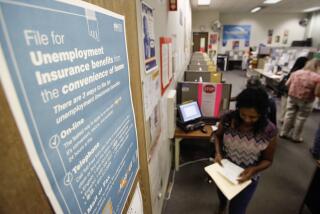VALLEY BUSINESS / HIRE HOPES: TRENDS IN THE JOB MARKET : Job Market Grows for Workers With Disabilities
- Share via
What Kathy Schroeder really wants for the clients she helps guide into the workaday world is nothing less than a life most ordinary. A regular job with a paycheck and co-workers who hang out together and sometimes make weekend jaunts to Magic Mountain.
Helping them find that normalcy is a challenge--one that only partly stems from the clients’ developmental disabilities, which range from cerebral palsy to epilepsy to mental retardation.
Part of the challenge has been traditions that steered workers with developmental disabilities into sheltered workshops--often cavernous settings offering low-wage, piecework jobs. Another was employer attitudes, in which the notion of hiring workers with physical or mental disabilities was discounted.
But today, many who work with disabled adults are seeing hopeful signs of a new labor force.
Technology is helping even the playing field for some physically disabled workers, offering the blind a chance to use computers, and the deaf an opportunity to work in office settings.
And the wall of employer reticence is beginning to crack, with growing numbers of employers locally and nationwide focusing more on worker ability than disability, say state and national experts.
“What I think you’re going to see is that an individual with a disability finally will be recognized as a full member of the community, just like anyone else,” said Schroeder, director of training for Jay Nolan Community Services in Mission Hills, which runs a “supported employment” program aimed at helping disabled adults get and keep jobs in the community. “It’s happening now.”
At the same time, there’s been a growing movement among support programs for disabled adults to channel more workers into everyday jobs, and out of the sheltered workshops that had for years served as virtually the only work outlet for people with developmental disabilities. Such workshops, in which clients often perform repetitive tasks such as shrink wrapping goods or putting items into packages for distribution, may offer the worker a comfortable, nonthreatening environment, but they do little to further the goal of workplace integration, experts said.
To encourage more employers to dip into this largely untapped talent pool, a presidential committee this spring launched a nationwide program dubbed Project Employ that’s expected to increase the numbers of workers with cognitive disabilities in the workplace.
The net result? As the nation prepares to celebrate Labor Day, more and more adults with disabilities now count themselves among the rank and file.
“Over the past couple of years, there has been at least a 40% to 60% increase in job opportunities for people with disabilities in the Valley,” said Norman Bennis, a counselor with the Jewish Vocational Service. “It has greatly improved.”
To many in the field, the road toward fuller workplace integration still looks long and hilly.
While the nation enjoys the lowest unemployment level in a generation, national unemployment rates for adults with physical and mental disabilities persistently hover around 50%, according to figures from the President’s Committee on Employment of People With Disabilities. For adults with severe disabilities, the unemployment rate in 1994--the most recent year available-- was near 75%.
State and local figures were not available. But anecdotally, local counselors and advocates for the disabled say that while the unemployment rate remains “ridiculously high,” they have seen substantial improvement in the local job market in the past two years.
“The climate of the business world has significantly improved in terms of people being willing to try,” said Kathryn Lincoln, a training and information specialist with the Van Nuys-based North Los Angeles County Regional Center, which serves adults and youths with developmental disabilities.
Lincoln, whose brother has Down syndrome, said she’s been able to place her clients at local firms and name-brand outlets like Home Depot, where they serve as stock clerks, or Circuit City, where they hold jobs in customer service. At United Artist Theaters, they hold jobs collecting tickets.
Others speak of helping their clients find jobs as bookkeepers, engineers and accountants.
“And that includes people getting promotions and not just being at that one level forever,” Lincoln said.
Of the 23 adults in the Jay Nolan program, 22 are working and 19 of those are working in the San Fernando or Santa Clarita valleys.
“Two days ago I received a call out of the blue from an employer [seeking information],” said Lincoln, who has been working with people with disabilities since she was a teen. “I was so thrilled that he was even considering this without a phone call from us.”
When telemarketer Gary Lasdon met his future employer, Van Nuys-based Bel-Air Exteriors, Lasdon’s use of a wheelchair was a nonissue, his boss said.
“I didn’t hire Gary because of or in spite of any perceived disability,” said Larry Cohen, president of the company, which specializes in doors, windows and other exterior home improvements. “Our job is working on the phone and he has no disability there.
“If the job description doesn’t involve running or lifting bales of hay, that other thing is irrelevant.”
Lasdon, who has used a wheelchair for more than three years because of cerebral palsy, says he had been offered two other jobs before he settled on Bel-Air, a contact initiated by Bennis, with the Jewish Vocational Service.
Even though he had his pick of jobs, Lasdon said he knows that others aren’t as lucky.
“Among the population, there’s still a lot of attitude out there,” said Lasdon, who lives in Northridge. “I happen to have been extremely fortunate in terms of my job search. But in general, it’s not an easy thing for people with disabilities to get and keep jobs.”
Technology is helping to improve the odds, experts said.
Nanette Phelan, controller for the Van Nuys-based Independent Living Center of Southern California, used as an example the fact that an East Valley resident with severe short-term memory loss is now able to travel to and from work with the aid of an on-board navigation system.
For disabled workers who are not quite ready for the real-world workplace, sheltered workshops remain an option. And even though many in the field see a movement away from sheltered workshops, figures show that such operations retain the bulk of the workers in the state’s Habilitation Services program.
More than 5,800 adults with developmental disabilities were in workshop settings in 1998, compared with 3,200 in individual placements, according to figures from the state Department of Rehabilitation.
New Horizons, a North Hills-based program that serves people with developmental disabilities, has 250 workers in its on-site work program, which includes sheltered workshops, and about 95 employed in individual settings.
Joseph Chu, director of development and marketing for the program, said he supports the move toward inclusion, but cautions that there are limitations.
“It’s probably not realistic to say that everybody can be out working in the community,” said Chu. “Working in a sheltered environment still has value for some.”
He noted that while the number of workers in his supported employment program has increased, the number in the sheltered workshop has not declined.
Other advocates say they anticipate such a decrease will come, accompanied by further increases nationwide in real-world, everyday jobs.
“The president’s committee is hearing more and more from employers about how to recruit people with disabilities,” said Jennifer Kaplan, spokeswoman for the committee. “That gives us a good feeling that when [updated census] numbers come in, they will be up.
“We see signs of progress everywhere.”
*
As luck would have it, I accidentally slammed my finger in a door minutes before I was to begin writing this column, inflicting an unbelievable amount of pain and resulting in a trip to the emergency room.
So in a timely slip-up, I got a tiny taste of what it’s like to work when part of your body isn’t up for the challenge.
After concentrating initially on how the throbbing splint-braced digit would interfere with my writing, I decided to focus instead on the nine remaining soldiers.
Aside from a few additional typos, they seemed to handle the job just fine. Interesting lesson.
Valley @ Work runs each Tuesday. Karen Robinson-Jacobs can be reached at Karen.R[email protected]
* GOOD TIMES ROLE
With the economy percolating, workers in the construction, teaching and animation fields are in big demand. Valley Business, B4
More to Read
Inside the business of entertainment
The Wide Shot brings you news, analysis and insights on everything from streaming wars to production — and what it all means for the future.
You may occasionally receive promotional content from the Los Angeles Times.










